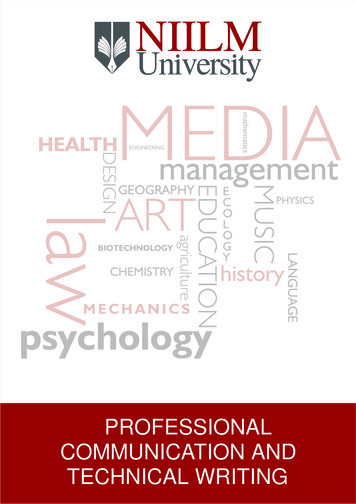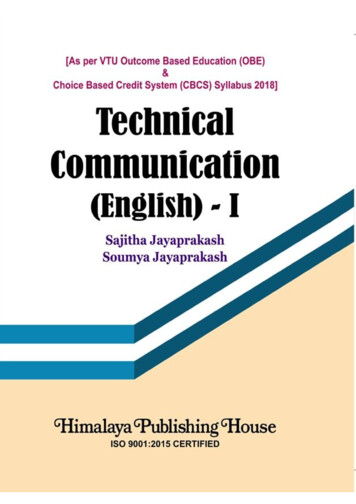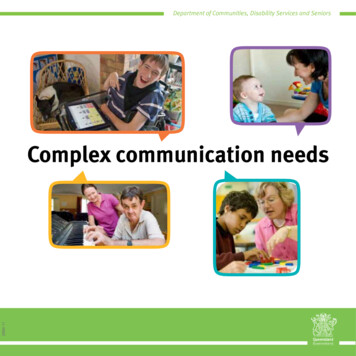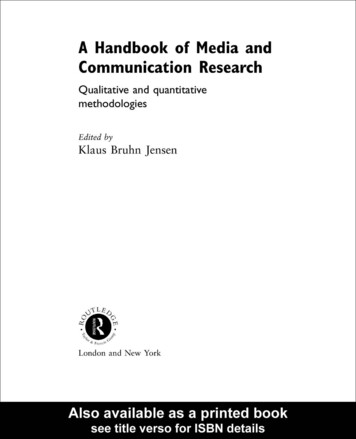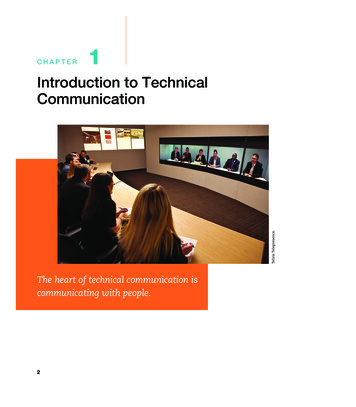
Transcription
CHAPTER1Teliris Telepresence.Introduction to TechnicalCommunicationThe heart of technical communication iscommunicating with people.201 MAR 67948 Ch01 001-016.indd 211/29/11 3:28 PM
C hapterAlthough high-tech tools such as this videoconferencing package from Teliris (2011) are becoming more important in theworkplace, the heart of technical communication remains whatit has always been: communicating with people. All technicalcommunication documents—whether e-mails, reports, Web sites, orany of a dozen other forms—are meant to help people learn, carry outtasks, and make decisions. This book is about the process of findingand creating technical information and communicating it to others.Employers in every industry stress the importance of communication skills. A study of over 400 U.S. companies, which together1 c o n te n t sWhat Is TechnicalCommunication? 4What Are Your Roles as aCommunicator? 5Technical Communicationand Your Career 6Characteristics of a TechnicalDocument 6Addresses Particular Readers 6Helps Readers Solve Problems 7employ 2 million people, found that almost all of them felt thatReflects the Organization’s Goalsand Culture 7the following skills are “very important” for new college graduatesIs Produced Collaboratively 8(Conference Board, 2006, p. 20):Uses Design to IncreaseReadability 8SkillPercentage of employers who thinkthe skill is “very important”Oral communication95.4Teamwork and collaboration94.4Professionalism and work ethic93.8Written communication93.1Consists of Words or Imagesor Both 8A Look at Three SampleDocuments 10Measures of Excellencein Technical Communication 12Honesty 12Clarity 13Accuracy 13A study of more than 100 large American corporations, whichComprehensiveness 13together employ 8 million people, suggests that writing is a moreAccessibility 14important skill for today’s professionals than it ever has been (CollegeConciseness 14Entrance Examination Board, 2004, pp. 3–4). Among the major find-Professional Appearance 14ings of the survey are the following:Correctness 14 For hiring and promotions, writing is a “threshold skill.” If yourjob-application materials are written poorly, 86 percent of companies surveyed would “frequently” or “almost always” hold itagainst you. If you somehow get the job, you won’t last longenough to be promoted. Two-thirds of professionals need strong writing skills in their dailywork. Some 80 percent of companies in the service, finance,insurance, and real-estate industries assess applicants’ writingduring the hiring process. Fifty percent of all companies in all industries consider writing skills in making promotion decisions.301 MAR 67948 Ch01 001-016.indd 311/29/11 3:28 PM
41Introduction to Technical Communication Half of all companies “frequently” or “almost always” produce reports, memos,and correspondence. Almost 100 percent of companies use e-mail, and morethan 80 percent use PowerPoint presentations.The working world depends on written communication. Within most modernorganizations, almost every action is documented in writing, whether on paper oronline. Here are a few examples: a memo or an e-mail to request information or to identify a problem a wiki with instructions that explain how to carry out a new task a proposal to persuade management to authorize a project a report to document a completed project an oral presentation to explain a new policy to employeesEvery organization also communicates with other organizations, customers, suppliers, and the public, using materials such as these: inquiry letters, sales letters, goodwill letters, and claim and adjustment letters tocustomers, clients, and suppliers Web sites to describe and sell products and to solicit job applications podcasts, videos, and posts on social-networking sites to introduce new products and services research reports for external organizations articles for trade and professional journalsWhat Is Technical Communication?You can look at technical communication in two ways: as the process ofmaking and sharing information and ideas in the workplace, and as a set ofapplications — the documents you write.Technical communication is the process of finding and using information and sharing meaning. The brief conversations you have with your colleagues in the hallway, the text messages you exchange with vendors, thephone calls with your project team — all these are examples of technicalcommunication.In fact, every professional spends most of every workday using the fourcommunication skills: reading, writing, speaking, and listening. Think of itthis way: a professional is a person who communicates with others about atechnical subject. An engineer is a person who communicates about engineering. An architect is a person who communicates about architecture. A biologist is a person who communicates about biology.Professionals often use these four communication skills to create, design,and transmit technical information so that people can understand it easily01 MAR 67948 Ch01 001-016.indd 411/29/11 3:28 PM
What Are Your Roles as a Communicator?15and use it safely, effectively, and efficiently. Much of what you read everyday — textbooks, computer-based training videos, procedures manuals, Websites, owner’s manuals — is technical communication.The purpose of this book is to help you improve your skills in the processof technical communication (finding information and developing ideas onyour own and with others) and in the applications of technical communication (the letters, reports, blogs, and other kinds of documents you will write).The focus of this book is on the techniques that skilled communicators useto analyze their audience and purpose, create and find the best informationon their subject, arrange it skillfully to meet their audience’s needs and preferences, and deliver it effectively using the most appropriate application.The principles you have studied in your earlier writing courses apply totechnical communication. The biggest difference between technical communication and the other kinds of writing you have done is that technical communication has a somewhat different focus on audience and purpose.In most of your previous academic writing, your audience has been your instructor, and your purpose has been to show your instructor that you have mastered some body of information or skill. Typically, you were not trying to createnew knowledge or motivate the reader to take a particular action—except togive you an A for that assignment.By contrast, in technical communication in the workplace, your audiencewill likely include peers and supervisors in your company, and perhaps people outside your company. Your purpose will likely be to reinforce or changetheir attitudes toward the subject you are writing about, motivate them totake particular actions, or help them carry out their own work-related tasks.For example, suppose you are a public-health scientist working for a federal agency. You have just completed a study showing that, for most adults,moderate exercise provides as much health benefit as strenuous exercise. Youmight report your results in a journal article for other scientists, in a press release distributed to popular print and online publications, and in a blog andpodcast on your agency’s Web site. In each case, you will present the key information in different ways to meet the needs of the various audiences.What Are Your Roles as a Communicator?Regardless of whether you are a technical professional (such as an electrical engineer, a chemist, or an accountant) or a technical communicator (a personwhose main job is to create applications such as manuals, reports, and Websites), you are likely to have three major roles as a communicator: The writer of a document. You will be the main author of documents andoral presentations. A member of a project team. As a member of a team, you will likely participate in writing one or more documents for various audiences.01 MAR 67948 Ch01 001-016.indd 5On TechComm WebFor a good introduction totechnical communication, seethe STC introduction to thesubject. Also see Tom Johnson’sblog. Click on Links Library forCh. 1 on bedfordstmartins.com/techcomm .11/29/11 3:28 PM
16Introduction to Technical Communication An information resource for people inside and outside your organization. Modern organizations run on information, and it’s everyone’s responsibilityto help provide it. You will communicate with your co-workers whenthey seek advice and information. In addition, you will communicatewith vendors, suppliers, and customers to help them understand yourindustry and your organization’s products and services.This book focuses on the strategies, techniques, and tools that you will use inall three of these roles.Technical Communication and Your CareerThe College Entrance Examination Board study referred to earlier suggeststhat communication skills are a “threshold skill” required to get and keep ajob (2004, pp. 3–4). A survey by the Plain English Network found that 96 percent of the nation’s 1,000 largest employers say employees must have goodcommunication skills to get ahead (2002).Job ads reflect this reality. The following ad from an organization thatmanufactures medical instruments is typical:This typical job ad mentions notonly computer skills but alsocommunication skills.In This BookFor more about job-applicationmaterials, see Ch. 15, p. 400.Design Assurance Engineer. Duties include performing electronic/mechanical product, component, and material qualifications. Requires spreadsheet/word-processingabilities, excellent client-relationship skills, and excellent written/oral communicationskills. BSEE or biology degree preferred.According to one survey, almost half of the largest U.S. companies offeror require training for professionals who cannot write well (College EntranceExamination Board, 2004, p. 4). The companies spent about 900 per employee for writing training. Would a company rather save that 900? Ofcourse. The facts of corporate life today are simple: if you cannot communicate well, you are less valuable; if you can, you are more valuable.Characteristics of a Technical DocumentAlmost every technical document has six major characteristics: it addressesparticular readers, helps readers solve problems, reflects the organization’sgoals and culture, is produced collaboratively, uses design to increase readability, and consists of words or images or both.Addresses Particular ReadersIn This BookFor more about addressing aparticular audience, see Ch. 5,p. 87.01 MAR 67948 Ch01 001-016.indd 6Technical documents address particular readers. For instance, if you areplanning to write a proposal for your supervisor, you might think about thatperson’s job responsibilities, the level of detail he or she would be interestedin reading, and personal factors such as history with the organization and attitudes toward your ideas. These factors help you decide what kind of docu-11/29/11 3:28 PM
Characteristics of a Technical Document17ment to write, how to structure it, how much detail to include, and what sentence style and vocabulary to use.Even if you do not know your readers personally, you can try to create aprofile of them. For example, if readers of your brochure are police officers responsible for purchases, you know that they share a police background and acommon responsibility for approving expenditures.Your writing might also be read by people you never intended as your audience: managers and executives in your organization, the public, or thepress. Avoid writing anything that will embarrass you or your organization ifother audiences read it.Often, you will write for people from different cultures or whose nativelanguage is different from yours. These readers will react differently to thedesign, organization, and writing style of documents than people from yourown culture will. Therefore, you should consider these cultural differences asyou write.A good first step is to read a full-length discussion of intercultural communication, such as one or more of the following respected resources:Hofstede, G. H., Hofstede, G. J., & Minkow, M. (2010). Cultures and organizations: Software for the mind (3rd ed.). New York, NY: McGraw-Hill.Jandt, F. E. (2009). An introduction to intercultural communication: Identities in aglobal community (6th ed.). Thousand Oaks, CA: Sage.Lustig, M. W., & Koester, J. (2009). Intercultural competence: Interpersonal communication across cultures (6th ed.). Boston, MA: Pearson (Allyn & Bacon).Neuliep, J. W. (2008). Intercultural communication: A contextual approach (4thed.). Boston, MA: Houghton Mifflin.Samovar, L. A., Porter, R. E., and McDaniel, E. R. (Eds.). (2008). Interculturalcommunication: A reader (12th ed.). Belmont, CA: Wadsworth.Another valuable resource is the Intercultural Communication Institute (www.intercultural.org). The articles, training, and resource lists available throughthis nonprofit organization offer a helpful introduction to the subject.Helps Readers Solve ProblemsTechnical documents help readers learn something or carry out a task. Forinstance, you might watch your company’s video on employee benefits tohelp you select a benefits package. In other words, you watch it because youneed information to analyze a situation and solve a problem.Reflects the Organization’s Goals and CultureTechnical documents further the organization’s goals. For example, a stategovernment department that oversees vocational-education programs submits an annual report to the state legislature, as well as a lot of technical information for the public: flyers, brochures, pamphlets, radio and television01 MAR 67948 Ch01 001-016.indd 711/29/11 3:28 PM
18Introduction to Technical Communicationads, and course materials. These documents help the department secure itsfunding and reach its audience.Technical documents also reflect the organization’s culture. For example,many organizations encourage their employees to blog about their areas ofexpertise. Blogging can help an organization establish an identity based onproducing high-quality products, using green energy and protecting the environment, helping the community, and many other values.Is Produced CollaborativelyIn This BookFor more about collaboration,see Ch. 4.Although you will often work alone in writing short documents, you willprobably work as part of a team in producing more-complicated documents.Collaboration is common in technical communication because no one personhas all the information, skills, or time to create a large document. Writers,editors, designers, and production specialists work with subject-matterexperts — the various technical professionals — to create a better documentthan any one of them could have made working alone.Collaboration can range from having a colleague review your two-pagememo to working with a team of a dozen technical professionals and technical communicators on a 200-page catalog. Social media such as wikis, blogs,and microblogs (such as Twitter) have made another kind of collaborationmore convenient. People routinely post questions to networks of friends andassociates — both inside and outside their own organization — to help themanswer technical questions.Uses Design to Increase ReadabilityTechnical communicators use design features — typography, spacing, color,special paper, and so forth — to accomplish three basic goals:In This BookFor more about design, seeCh. 11. To make the document look attractive and professional. If it is attractive andcreates a positive impression, you are more likely to accomplish your goal. To help readers navigate the document. Because a technical document canbe long and complicated and most readers want to read only parts of it,design features such as headings, color, and highlighting help readerssee where they are and get to where they want to be. To help readers understand the document. If all the safety warnings in a manual appear in a color and size different from the rest of the text, readerswill be better able to recognize the importance of the information.Consists of Words or Images or BothMost technical documents include words and images — both static graphicsand moving images. Images help the writer perform five main functions:In This BookFor more about graphics, seeCh. 12.01 MAR 67948 Ch01 001-016.indd 8 make the document more interesting and appealing to readers communicate and reinforce difficult concepts11/29/11 3:28 PM
Characteristics of a Technical Document19INTERACTIVE SAMPLE DOCUMENTStudying How Technical Communication CombinesWords, Graphics, and DesignThis is a page from a brochure from Xerox describing two products. The questions in themargin ask you to consider how technical communication combines words and graphics.1. How has the companyused words and graphics to communicatedifferent kinds ofinformation?Robust multifunction performance that easilykeeps up with the busy pace of your entire office. One space-saving device does the work of fourstandalone machines, combining powerfulprinting, copying, scanning and faxing. Fast color at up to 20 ppm lets your entireworkgroup enjoy the benefits of colorwithout slowing down.The Phaser 6180 laser printer gets your jobsout quickly. Very quickly. A print speed of up to 20 ppm in full colorbrings your work to colorful life withoutslowing you down. Print black-and-white—even complex or largejobs—at up to a speedy 26 ppm thanks to apowerful 400 MHz processor and 128 MB ofmemory (expandable to 1.152 MB). A first-page-out time as quick as 10 secondsmeans your job’s out faster than your trip tothe printer. The 60,000-page-per-month duty cycleeasily handles a steady flow of officedocument demands. Black-and-white prints at up to a quick 31 ppmregardless of your job’s size or complexity,thanks to a 400 MHz processor and 348 MB ofmemory (expandable to 1.408 MB). A scan speed of up to 7 color or 20 black-and-whitescans per minute lets you quickly go from paper to digital. Walk-up fax and LAN fax (fax from the print PCL driver)delivers up to 400 x 400 dpi resolution, and includes JBIGcompression technology for faster transmissions.Intuitive control panel makes copy, faxand scan functions easy to use, and alsodisplays job status and toner levels.One-button copying makes walkup usequick and easy. No need navigating amenu just to make a copy.2. How has the companyused design to helpreaders understand thatthis page describes twodifferent products?3. How has the companyused color to help readers understand themessages that it wishesto communicate?On TechComm WebTo submit your responsesto your instructor, click onInteractive Sample Documentsfor Ch. 1 on bedfordstmartins.com/techcomm .Phaser 6180MFP control panelSource: Xerox, 2007 www.office.xerox.com/latest/61CBR-01U.PDF .01 MAR 67948 Ch01 001-016.indd 911/29/11 3:28 PM
101Introduction to Technical Communication communicate instructions and descriptions of objects and processes communicate large amounts of quantifiable data communicate with nonnative speakersTechnical professionals and technical communicators alike use high-techtools to produce documents. Although you are unlikely to need to become anexpert user of these tools, some of them, such as word processors andspreadsheets, are fundamentally important. Throughout this book, Tech Tipssuggest ways to make the most of these tools.A Look at Three Sample DocumentsCharacteristics of technicalcommunication: addresses particularreaders: This poster isaddressed to Spanishspeaking children and theircaregivers in the United States. helps readers solveproblems: It providesinformation about theelements of a balanced diet. reflects the organization’sgoals and culture: It isintended to show thatthe organization (the U.S.Department of Agriculture)works to improve children’snutrition. is produced collaboratively:The poster was created bynutrition experts, technicalcommunicators, graphic artists,Web authors, and others. uses design to increasereadability: The width ofeach color-coded food groupis intended to suggest howmuch of that food group achild requires. Elsewhere onthe poster this concept iscommunicated in more detail. consists of words or imagesor both: The words, colors,and graphics are used tomake the message clear andeasy to understand.01 MAR 67948 Ch01 001-016.indd 10Figures 1.1 (below), 1.2 (page 11), and 1.3 (page 12) illustrate a number of thecharacteristics of technical communication discussed in this chapter.Figure 1.1 A Poster That Shows the Characteristics of Technical CommunicationSource: U.S. Department of Agriculture, 2005 www.mypyramid.gov/downloads/sp-MiniPoster.pdf .11/29/11 3:28 PM
A Look at Three Sample Documents11Characteristics of technicalcommunication: addresses particularreaders: This page is froma white paper addressedto managers interested inlearning about the company’scustomer relationshipmanagement software. helps readers solveproblems: The page explainshow the software is easyto use and shows the userinterface. reflects the organization’sgoals and culture: This whitepaper focuses on usability:making the product easy touse for the customer. Theexplanations, the image, andthe marginal quotation allfocus on this goal. is produced collaboratively:It was created by the productexperts, with the help oftechnical communicators. uses design to increasereadability: The threeelements — the textualexplanation, the screenshot, and the marginalquotation — work together tomake an argument. consists of words or imagesor both: The words explainthe argument; the graphicshows what the words say.ACT! by SageWhile creating ACT! 2010 we emphasized a number of usability and productivity related themes. Ourfirst focus area was on navigation. Navigation is the act of finding your way around in a softwareproduct. Similar to navigating when traveling by car, there sometimes are easy paths and sometimesdifficult paths depending on the route and the signs provided. Our goal was to make navigation aseffortless as possible. We did this by creating simplified “context-driven” menus, by including a familiar“PC-style” navigation scheme to access views, and by augmenting the traditional top-of-screen toolbarwith big “easy buttons” to allow instant recognition and access to the most frequently used functions.In addition, we added a persistent Lookup box, so you can search for information more quickly(Figure 1).1“Our goal was to makenavigation as effortless aspossible.”Figure 1: Contact Details Screen Showing New User Interface ElementsSecond, we added a customizable Welcome page as a home base for users (Figure 2). This newscreen is a navigational aid and a touchpoint for beginning ACT! users. It is also a place for all ACT!users to discover important features and how to use them. It exposes advanced features and providesassistance to experienced users who need to access infrequently used functionality. It also provides aview tailored specifically for Administrators.On TechComm WebACT! by Sage 2010: Delivering on Usability and Productivity5To view Figs. 1.1–1.3 incontext on the Web, clickon Links Library for Ch. 1on bedfordstmartins.com/techcomm .Figure 1.2 A White Paper Page That Shows the Characteristics of TechnicalCommunicationSource: Sage Software, 2009 http://download.act.com/act2010/docs/act 2010 usability andproductivity whitepaper.pdf .01 MAR 67948 Ch01 001-016.indd 1111/29/11 3:28 PM
121Characteristics of technicalcommunication: addresses particular readers:This Web page is addressedto prospective buyers of thecompany’s software. helps readers solveproblems: All theelements—the text, the links,and the video—are intendedto answer readers’ questionsand show that the product isa good value. A set of links onthe right is called “Solve YourProblem.” reflects the organization’sgoals and culture: Thispage contains numerouselements — from the photo tothe logos from social-mediasites such as Facebook — thatsay that the company will bethere to help readers solvetheir problems. is produced collaboratively:It was created by a writer, withthe help of a photographer, avideographer, a designer, anda Web specialist. uses design to increasereadability: Althoughthis page contains a lotof information, it is welldesigned, with navigationinformation spanning the topand a balanced three-columndesign in the main contentarea of the screen. consists of words or imagesor both: Like much technicalcommunication, this Webpage consists of words,images (such as photographsand logos), and video.Introduction to Technical CommunicationFigure 1.3 A Q&A That Shows the Characteristics of Technical CommunicationSource: Marathon Technologies, 2010 www.marathon1.com/why marathon video.html .Measures of Excellence in TechnicalCommunicationEight measures of excellence characterize all technical communication: honesty, clarity, accuracy, comprehensiveness, accessibility, conciseness, professional appearance, and correctness.HonestyIn This BookFor more about the ethicaland legal aspects of technicalcommunication, see Ch. 2.The most important measure of excellence in technical communication is honesty. For three reasons, you have to tell the truth and not mislead the reader: It is the right thing to do. Technical communication is meant to help peoplemake wise choices as they use the information available in a high-techculture. If you are dishonest, readers can get hurt. Misinforming your readers or deliberately omitting important information can defraud, injure, or kill people.01 MAR 67948 Ch01 001-016.indd 1211/29/11 3:28 PM
Measures of Excellence in Technical Communication113 If you are dishonest, you and your organization could face serious legal charges.If a court finds that your document’s failure to provide honest, appropriate information caused a substantial injury or loss, your organizationmight have to pay millions of dollars.ETHICS NOTEYou will find Ethics Notes throughout this book. These notes will describe typical ethicalproblems related to technical communication and suggest ways to think about them.ClarityYour goal is to produce a document that conveys a single meaning the readercan understand easily. The following directive, written by the British navy(Technical Communication, 1990), is an example of what to avoid:It is necessary for technical reasons that these warheads should be stored upsidedown, that is, with the top at the bottom and the bottom at the top. In order that theremay be no doubt as to which is the top and which is the bottom, for storage purposes,it will be seen that the bottom of each warhead has been labeled with the word TOP.Technical communication must be clear for two reasons: Unclear technical communication can be dangerous. A carelessly draftedbuilding code, for example, could tempt contractors to use inferior materials or techniques. Unclear technical communication is expensive. The average cost of a telephonecall to a customer-support center is more than 32 (About.com, 2008).Clear technical communication in the product’s documentation—itsinstructions—can greatly reduce the number and length of such calls.AccuracyYou need to get your facts straight. A slight inaccuracy can confuse and annoy your readers; a major inaccuracy can be dangerous and expensive. In another sense, accuracy is a question of ethics. Technical documents must be asobjective and unbiased as you can make them. If readers suspect that youare slanting information — by overstating or omitting facts — they will doubtthe validity of the entire document.ComprehensivenessA good technical document provides all the information readers need. Itdescribes the background so that readers unfamiliar with the subject canunderstand it. It contains sufficient detail so that readers can follow the01 MAR 67948 Ch01 001-016.indd 1311/29/11 3:28 PM
141Introduction to Technical Communicationdiscussion and carry out any required tasks. It refers to supporting materialsclearly or includes them as attachments.Comprehensiveness is crucial because readers need a complete, selfcontained discussion in order to use the information safely, effectively, andefficiently. A document also often serves as the official company record of aproject, from its inception to its completion.AccessibilityIn This BookFor more about makingdocuments accessible, see Chs.9 and 11.Most technical documents — both in print and online — are made up of small,independent sections. Because few people will read a document from the beginning to the end, your job is to make its various parts accessible. That is,readers should not be forced to flip through the pages or click links unnecessarily to find the appropriate section.ConcisenessIn This BookFor more about writingconcisely, see Ch. 10.A document must be concise enough to be useful to a busy reader. You canshorten most writing by 10 to 20 percent simply by eliminating unnecessaryphrases, choosing shorter words, and using economical grammatical forms.Your job is to figure out how to convey a lot of information economically.Professional AppearanceYou start to communicate before anyone reads the first word of the document. If the document looks neat and professional, readers will form a positive impression of it and of you. Your document should adhere to the formatstandards of your organization or your professional field, and it should bewell designed and neatly printed. For example, a letter should follow one ofthe traditional letter formats and have generous margins.CorrectnessA correct document is one that adheres to the conventions of grammar,punctuation, spelling, mechanics, and usage. Sometimes, incorrect writingcan confuse readers or even make your writing inaccurate. The more typicalproblem, however, is that incorrect writing makes you look unprofessional. Ifyour writing is full of errors, readers will wonder if you were also careless ingathering, analyzing, and presenting the techni
The principles you have studied in your earlier writing courses apply to technical communication. The biggest difference between technical commu-nication and the other kinds of writing you have done is that technical com-munication



